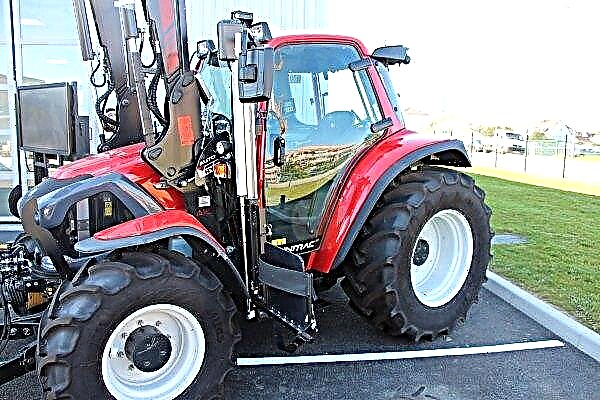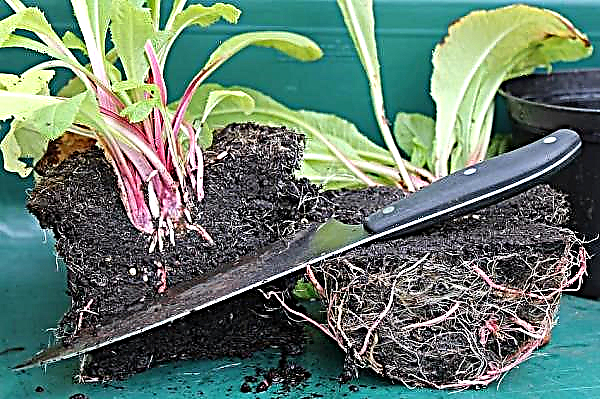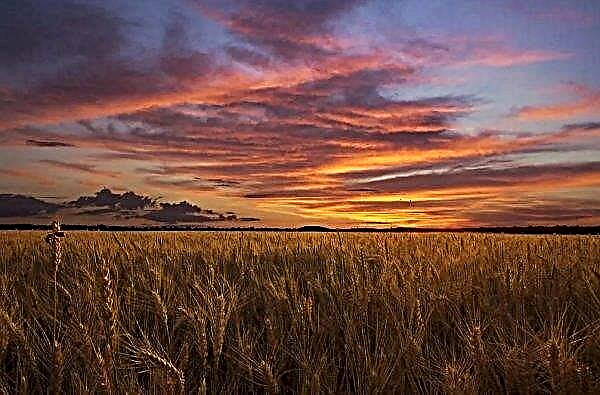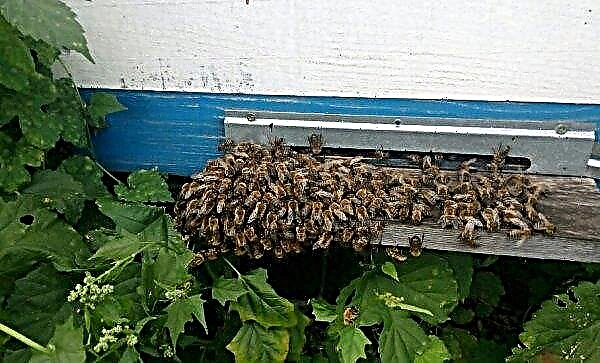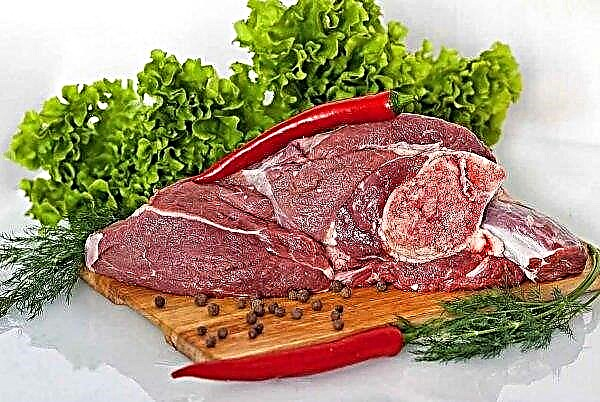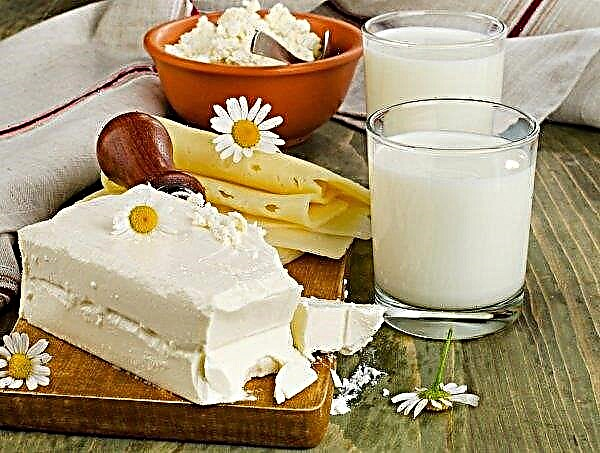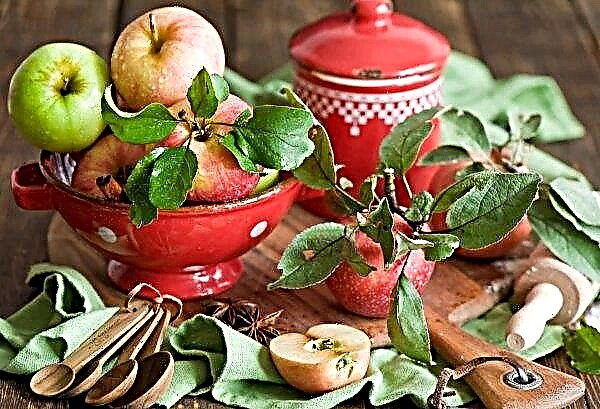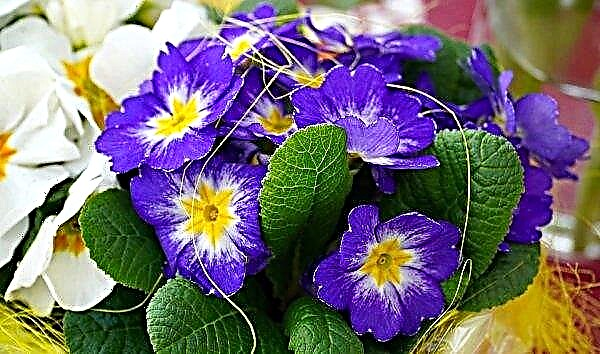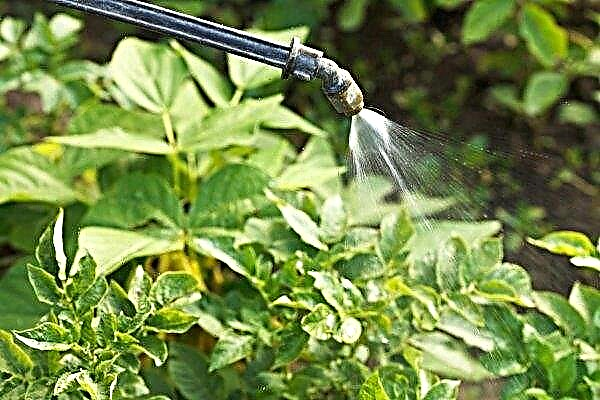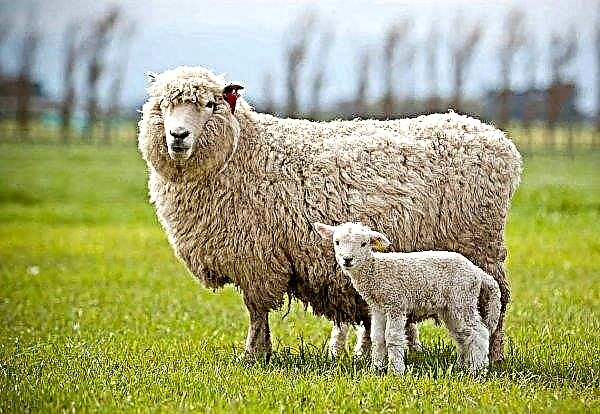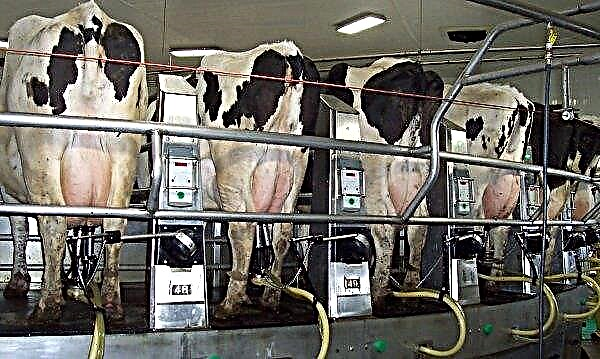Despite the many bred varieties of apples, the Bryansk golden remains invariably popular for growing in the middle lane for many years. Let us consider in more detail what this variety is like, how to plant and grow it on a site at home in order to get a plentiful harvest.
Description of apple variety Bryansk Golden
A variety of breeders led by A. I. Astakhov, working at the VNII Lupine Research Institute in Bryansk, brought the apple of the Bryansk Golden variety. To obtain the variety Antonovka vulgaris and Golden Delishes were crossed. As a result of crossing, a late winter variety was obtained with new characteristics and the appearance of a plant with fruits.
Did you know? The homeland of apples is considered the territory of modern Kazakhstan, translated as the capital of Almayou mean father of apples.
The tree of Golden Bryansk is characterized by medium growth power, reaches a height of 5–7 m. Each year, a young seedling is able to add about 60 cm in growth. 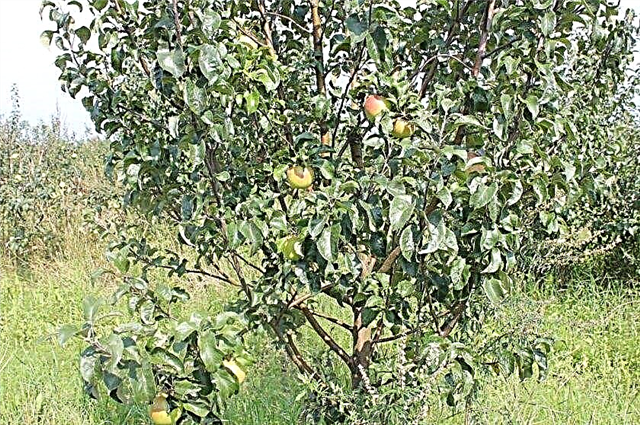 The branches directed upward are located on the main trunk at an obtuse angle, forming a lush large crown of a rounded shape, with medium thickened foliage. The variety is self-fertile and does not need to be planted additional apple trees on the site for harvest.
The branches directed upward are located on the main trunk at an obtuse angle, forming a lush large crown of a rounded shape, with medium thickened foliage. The variety is self-fertile and does not need to be planted additional apple trees on the site for harvest.
Fruit Characteristics
The fruits of Bryansk Golden grow large, the average weight of an apple is 200 g, and have a rounded-oblong shape. Appearance is attractive, all apples are about the same size, so they look aesthetically pleasing when sold.
The peel of the apple is golden yellow, with multiple subcutaneous dots, which are their hallmark. The fruits are characterized by a pleasant sweet and sour taste, dense, grainy, juicy white pulp.
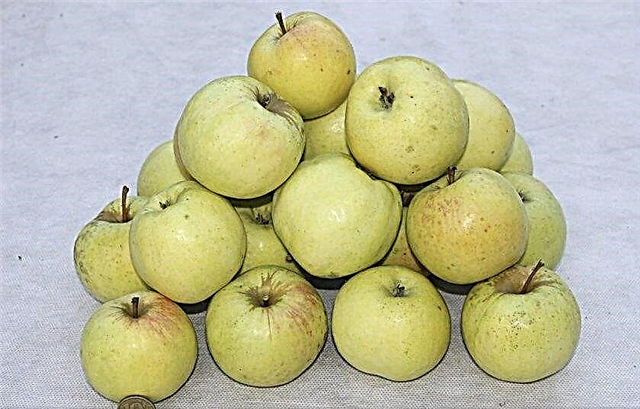
Advantages and disadvantages of the variety
Each variety has its own advantages and disadvantages that help gardeners in choosing a new specimen for planting on the site, so we will consider the main advantages and possible disadvantages of growing Golden Bryansk.
- The advantages include:
- high resistance to scab and fungal diseases;
- excellent commercial quality of the crop;
- stable annual productivity;
- self-fertility;
- high resistance to severe frosts;
- universality of the use of fruits.
The disadvantage that gardeners most often emit when growing Bryansk golden is the loss of taste during long-term storage - the flesh becomes loose, the juiciness is lost.
Grade Pollinators
The variety is self-fertile, that is, during pollination, the tree uses its own pollen and does not require the cultivation of other pollinating plants on the site. The main advantage of self-pollinating the tree is the possibility of obtaining a crop even under adverse environmental conditions, since pollination and the formation of the ovary in the flower occurs independently before it blooms.
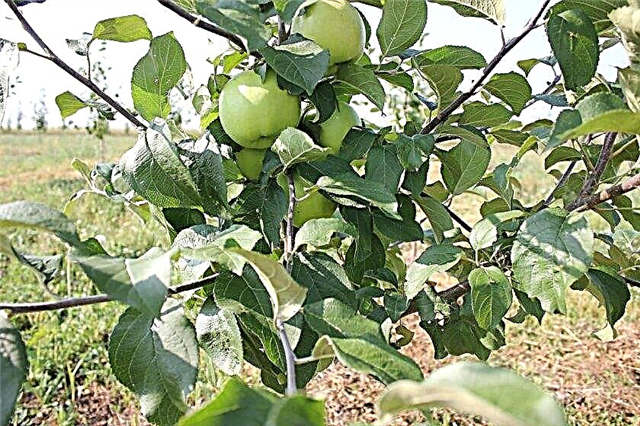
However, self-fertile trees that grow far from other apple trees have slightly reduced yield indicators. To increase the yield, it is recommended to plant several other varieties next to Bryansk golden, for example, Bryansk red and Bryansk pink, the flowering period of which coincides.
Apple yield
Annual fruiting, sometimes with slight fluctuations in the amount of yield, allows you to grow only this variety on the site.
The first crop after planting a seedling can be obtained already in the 4th year of growing Bryansk golden. In the early years, fruiting is quite plentiful, up to 100 kg per apple tree, by the 6th year of cultivation, productivity increases to 200 kg per apple tree.

Specialized horticultural firms achieve even higher yields - 350 c / ha. The maximum yield, which was recorded during the cultivation of the variety, was 600 c / ha.
Frost and drought resistance
Resistance to low temperatures in Bryanskiy Golden as for a variety bred in the middle zone and temperate climate is very high. The tree can withstand frosts down to –35 ° C, and flower buds will calmly survive small frosts.
Important! The risk of plant freezing increases significantly when grown in a swampy area or place with a high occurrence of groundwater.
Resistance to drought at Bryansk Golden - medium. The variety normally tolerates the absence of watering, subject to regular natural rainfall. However, during periods of drought in hot summers, it is better to water the apple trees in order to achieve high yields.
Planting and caring for an apple tree
Regardless of the variety of the selected apple tree, the seedling needs to be planted correctly in a suitable area and to regularly carry out agrotechnical methods to keep the plant healthy and stimulate high-quality abundant fruiting.
Landing Features
The best time for planting the Bryansk Golden Apple tree is autumn (late September - early October). Planting at this time will allow the seedling to quickly begin and build up a strong root system before winter.

In the middle lane, young apple trees usually winter well, and in the spring they actively begin to increase the height of the trunk and additional fruit branches. It is also possible to plant in the spring (late April), but there is a risk of missing the optimal planting time, which can cause poor survival of the seedling.
It is important not only to plant an apple tree on time, but also to choose the right seedling itself, as well as to prepare a place suitable for planting. Difficulties with the selection of a suitable seedling of Bryansk golden usually does not arise, it is chosen the same way as any other. First of all, pay attention to age - preferably not older than 2 years, preferably 1 year.
The number of branches on the apple tree is not more than 4, the trunk is even, strong, with a uniform smooth bark. The height of a quality healthy seedling is from 1.5 m, but not more than 1.8. When choosing a seedling, they must inspect the root system: a healthy appearance, a large number of small roots and up to 5 main processes are prerequisites for acquiring a young plant.

In addition, pay attention to the quality of the root system, it should not be dry, have mechanical damage, cracks, traces of diseases or the activity of pests.
Important! It is not recommended to purchase seedlings that are planted in separate containers and there is no way to inspect the roots — usually poor quality specimens mask it.
The variety grows best on loamy soils in well-drained soil, but you can create favorable growing conditions on your own. In swampy areas, landing should be performed on a hill, having previously prepared a high drainage layer - up to 1 m in depth. On soils of other types, before planting, the seedlings form a thick layer of sand, peat and compost, up to 1 m thick, on which the apple tree will be planted.
The landing site should be well-lit, not blown, which will allow the young tree to normally survive the cold winters. The optimal planting scheme for the variety under consideration is the preservation of free space of 3 m between trees and 5–7 m between rows.
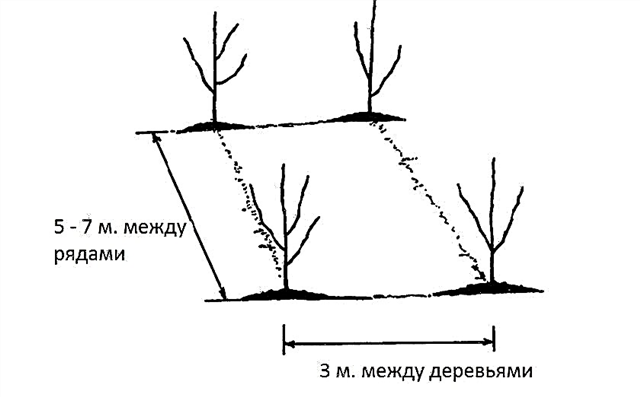
The technology of planting a seedling is as follows:
- Initially, a pit is prepared 2 weeks before the planned disembarkation date, the size of the pit is 1 m per 1 m.
- A mixture of the topsoil (2 parts), humus (1 part), peat (1 part), phosphorus-potassium fertilizers (the amount must be checked with the instructions), ash (200 g) is poured at the bottom of the pit (2/3). Leave for 2 weeks.
- A stake is driven into the center of the pit, a seedling is placed, and a soft, natural cloth is fixed to the stake.
- The roots straighten and cover the pit with a layer of fertile soil, tamping a little.
- The trunk circle is watered abundantly so that the voids that formed between the roots are well compacted.
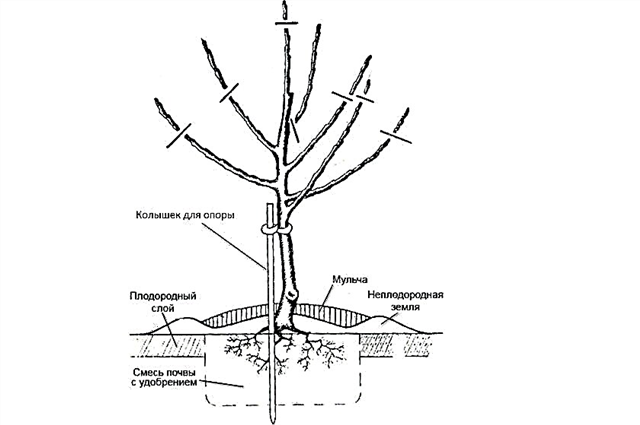
Watering and fertilizer
Watering the apple trees is definitely recommended in hot and dry summers, at this time the soil should be moistened once every 2 weeks, pouring a large amount of water into the trunk circle. A tree aged 2–5 years is watered with 3 buckets of water, 6–15 years old - with 6 buckets of water, over 16 years old - up to 10 buckets per 1 apple tree.
Fertilizing the tree is necessary to increase productivity and the overall normal growth of the tree:
- The first top dressing is carried out in May, at this time 0.5 urea of urea is introduced into the soil. l on 1 m² of the trunk circle, after application - well watered.
- The second time the plant is fed in June, a solution (per 10 liters of water) of copper sulfate (2 g) and boric acid (0.5 g) is added.
- In August, another top dressing is performed with superphosphate (20 g) and calcium chloride (30 g) per 1 m².
- The last top dressing is carried out in September after harvesting. At this time, the trunk circle is fertilized with rotted manure for digging - up to 6 kg per 1 m² of trunk circle.
Pruning branches
Annual spring pruning of branches is a necessary procedure that is performed before buds open. In mid-April, when the air temperature is already more or less stable, they remove weak, sick, broken, dry branches, as well as shoots that grow inside the crown. It is necessary to cut them off with a sharp sterile instrument completely, without leaving bitches.

Whitewash tree
Whitewashing of the trunk of the apple tree is carried out 2 times a year and has different purposes:
- In the spring, whitewashing allows you to protect the tree trunk from temperature extremes leading to cracking of the bark.
- Autumn whitewashing destroys pests that settled in the bark during the growing season.
To prepare a remedy for spring whitewash, use:
- 300 g of lime;
- 2 tbsp. PVA glue;
- 2.5 liters of water.
Mix all components thoroughly until a homogeneous mixture is formed. Before applying the product, the bark is prepared a little, cleaning from old particles with a spatula. The product should be applied to the bark of trees using a special brush for whitewashing in 1-2 layers.

To protect the tree from pests and diseases, the composition of the whitewash will be as follows:
- 2.5 l of chamomile infusion;
- 2 tbsp. copper sulfate;
- 2 tbsp. PVA glue;
- 2 drops of a Knockdown type product.
Winter preparations
Young trees are recommended to be insulated for the winter in order to keep the roots and trunk from freezing.
Did you know? The main part of the nutrients in the apple is concentrated immediately under the peel, therefore, cleansing the fruit from the peel, you cut off all the most useful.
The procedure is carried out as follows:
- Loosen the soil around the stem.
- The trunk circle is mulched with wood sawdust, needles or peat, while the mulch layer should be from 10 cm.
- They spud the trunk of the tree with soil, the height of the hill after hilling should be at least 30 cm.
- If a sufficient amount of snow falls in the winter, the entire trunk is sprinkled with it, ramming the trunk circle well.
Diseases and Pests
The resistance of Golden Bryansk to diseases and pests is above average, however, under adverse environmental conditions, a tree can be affected:
- scab - a fungus that settles on the leaves, soon passing to the fruits. It appears in the form of brown spots on the deciduous part and a dark crust on the fruits. Prevention of the disease is the regular application of ash, potash, compost and timely trimming of old diseased branches. When a tree is damaged, the tree trunk and the plant itself are treated with Bordeaux liquid or copper sulfate according to the instructions on the package;

- fungus fungus - it affects the ground part of the plant, sucks out most of the nutrients from the trunk, the tree begins to hurt and may die. If a fungus is found, it is immediately cut with a knife at the very base. It is important to manage to do this in time before the mushroom has hardened, otherwise you will have to use an ax, which can severely damage the tree trunk. After the destruction of the fungus, the affected area is treated with copper sulfate according to the instructions and painted over with oil paint;
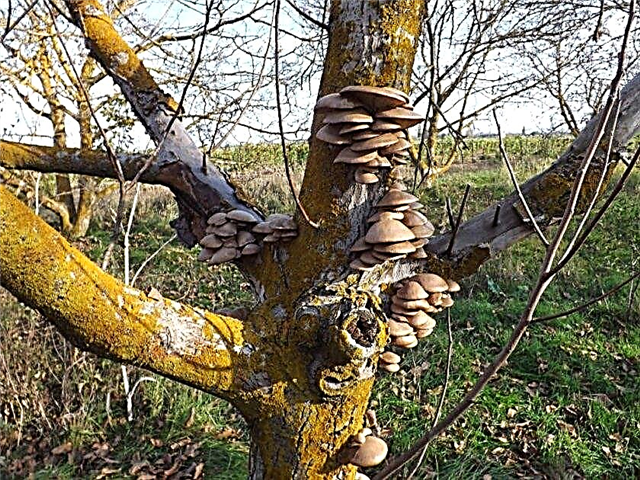
- apple moth - It is a butterfly with small gray wings that feeds on fruits. Preventive measures to prevent tree damage by a pest should be aimed at the timely destruction of dry and damaged branches, old bark, and annual digging of the trunk circle. Chemicals that help against the moth: Calypso, Intavir, Decis. Prepare and use chemical solutions according to the instructions;

- mining moth - a small yellow-gray butterfly that feeds on leaves, weakens the tree, is a carrier of dangerous diseases. Prevention against mining moths is the same as from the apple moth, as the larvae winter in the damaged parts of the tree and in the near-stem circle in the soil. Pest control is necessary by treating the plant with Decis, Karbofos, Dimilin according to the instructions.

Harvesting and storage
At the end of the first autumn month, the time of harvest is suitable. It is necessary to pick fruits on a sunny, dry day to maximize their shelf life. Apple picking should take place with the stalks, carefully so as not to damage the surface of the peel.
It is better to fold the harvested crop immediately in wooden or fruit boxes, where it will be stored in the future. The place for storing fruits should be cool, the optimum temperature - +2 ... + 5 ° C, air humidity - up to 70%. At home, apples are usually stored in the cellar or in the refrigerator. For industrial purposes, special fruit refrigerated rooms are equipped for storage.
Did you know? More than 7 thousand varieties of apples have already been bred in the world, but only about 100 varieties are grown for sale.
Tips from experienced gardeners
Consider some useful tips from experienced gardeners that will help with the cultivation of apple trees of the Bryansk Golden variety:
- To make the apple tree as fruitful as possible, it is recommended that large fruit branches be tied to supports for horizontal growth orientation. On such branches, fruits are formed in greater numbers and ripen evenly.
- On young trees, one fruit is removed from each “bunch” of apples, thus reducing the number of fruits, it will be easier for the apple tree to “cope” with the crop. Otherwise, the apple tree does not have enough strength and nutrients to save all the fruits, most of which will simply crumble.
- You can increase the yield of apple trees by adding zinc sulfate (3 kg per 1 ha) to the soil before flowering.
- Watering the apple tree should be stopped 2 weeks before harvesting - this will protect the fruits from cracking and extend their shelf life.

Thus, the apple variety Bryansk Golden has a high stable yield and a long shelf life of fruits, so gardeners often choose it for growing at home.In order for the planting procedure and cultivation agricultural technology to be understandable and as simple as possible for beginner gardeners, the article contains the main points that must be performed to obtain a plentiful harvest and maintain the tree in a healthy condition.





